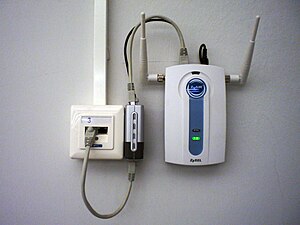Power over Ethernet or POE. A switching technology that allows your network cables to deliver both data and electricity to a device. Centralizing power distribution and reducing your consumption of 120v plugs throughout your office.

Power over Ethernet, or PoE, describes any of several standard or ad hoc systems that pass electric power along with data on twisted pair Ethernet cabling. This allows a single cable to provide both data connection and electric power to devices such as wireless access points, IP cameras, and VoIP phones.
There are several common techniques for transmitting power over Ethernet cabling. Three of them have been standardized by IEEE 802.3 since 2003. These standards are known as Alternative A, Alternative B, and 4PPoE. For 10BASE-T and 100BASE-TX, only two of the four signal pairs in typical Cat 5 cable are used. Alternative B separates the data and the power conductors, making troubleshooting easier. It also makes full use of all four twisted pairs in a typical Cat 5 cable. The positive voltage runs along pins 4 and 5, and the negative along pins 7 and 8.
Alternative A transports power on the same wires as data for 10 and 100 Mbit/s Ethernet variants. This is similar to the phantom power technique commonly used for powering condenser microphones. Power is transmitted on the data conductors by applying a common voltage to each pair. Because twisted-pair Ethernet uses differential signaling, this does not interfere with data transmission. The common-mode voltage is easily extracted using the center tap of the standard Ethernet pulse transformer. For Gigabit Ethernet and faster, all four pairs are used for data transmission, so both Alternatives A and B transport power on wire pairs also used for data.
4PPoE provides power using all four pairs of a twisted-pair cable. This enables higher power for applications like PTZ cameras, high-performance wireless access points, or even charging laptop batteries.
In addition to standardizing existing practice for spare-pair (Alternative B), common-mode data pair power (Alternative A) and 4-pair transmission (4PPoE), the IEEE PoE standards provide for signaling between the power sourcing equipment (PSE) and powered device (PD). This signaling allows the presence of a conformant device to be detected by the power source, and allows the device and source to negotiate the amount of power required or available.
